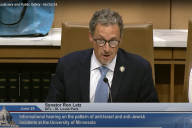You have /5 articles left.
Sign up for a free account or log in.

Istockphoto.com/tatiana_Stulbo
Making your first transition from a faculty role to one in the administration can feel like experiencing the university from the inside out. Your commute to work may well be the same, and you’re probably working on the same campus. But in many cases, that’s where the familiar ends and the wild surprises begin.
Colleges and universities are siloed institutions, and for the most part, faculty members are specialists within those silos. Most of us don’t know what we don’t know about other professionals in the educational mission; although we work side by side, we are too often invisible to one another.
As faculty, we spend our time on our campuses working hard within our departments, labs, centers, programs and maybe our schools. We spend our professional lives within our disciplinary organizations. We have little awareness of the dedicated colleagues who work all around us -- whose existence is often, insultingly, dismissed as “administrative bloat.” For us -- George and Carolyn -- it was by turns humbling and inspiring to become aware that we faculty are an important but relatively small part of the human infrastructure that carries out an institution’s educational mission.
This is the first in a series of articles about strategic alliances: partnerships available for faculty members all across campus that can help us be better educators and more thoughtful and well-informed campus citizens. We have our own ideas about the strategic partnerships that have been most transformative to us, both as administrators and as faculty members. But we want to hear from you, too. What questions do you have about your institution? Who flies under the radar, perhaps, but has emerged as indispensable to some aspect of your work?
The Student-Facing Perspective
Today, we begin where all things begin: with students. What do we mean when we talk about the “student experience”? What gets lost in the gap between what students think of as the student experience and what their faculty think that means?
Sure, it depends on whether the student in question is on a residential or commuter campus, or pursuing her course of study online. It makes a difference whether that student is a new undergrad, an A.B.D. grad student or an almost-doc finishing up the last few clinical rotations before the M.D.
As large as we faculty members know we loom in our students’ minds, especially around midterms and final exams, we are in fact just one set of the many pieces within the complex puzzle of each student’s daily experience of an educational institution. Here, for example, are a few other staff roles that face our students directly -- and that help to form a student’s campus mosaic.
- Academic adviser
- Counselor
- Financial aid officer
- Academic support staff, including for disabilities
- Work-study supervisor
- Lab manager
- Professional development staff
- Internship manager
- Affinity space and group sponsor
- First-generation program staff
- Conductor, director or entrepreneurship mentor
- Academic department administrator
- Coach
- Food-service worker
- Campus police
- Residence hall maintenance staff
- Librarian
- IT support staff
- Title IX coordinator
- Greek life or other student organization staff
- Facilities maintenance
- Tutor
- Parking and transportation staff
- Landscaper
Add several professors every semester to the mix, and then consider this puzzle from the student’s perspective. On any given day, any one of us -- faculty or staff member -- might well be the right person at the right time to help a student in need. Or the right person at the right time to help a student make the next cognitive or developmental leap.
As David M. Perry has recently written, “Everyone who works in academe has chosen to be part of the educational mission.” And from the perspective of our students, all of us together -- not just the faculty alone -- are instrumental to the quality of that educational mission. Again, Perry: “Staff members usually know how academe works. Many of us are in roles that make us as much responsible for student learning as the faculty. We should always approach one another as colleagues. But all too often, that’s not the case.”
Take, for example, the rich possibilities for collaborative learning that we find when we engage with colleagues in our campuses’ student life or student affairs divisions. Leadership and staff in student life work with students day in and day out. As often as not, this work occurs after hours, when faculty have packed up and left for the day. What are the most effective ways to understand the capacity for integration of our shared work with students? What do we gain by thinking of our work as shared? As we work toward more diverse and inclusive classrooms, what do we have to learn from the people on the campus who may be experts in what’s on our students’ minds? In how they see their world?
Consider inviting a colleague in student affairs to lunch, to learn about that person’s work and perspective on the campus. You might even drop an email message to the vice chancellor, vice president or vice provost for student affairs and ask for an informational interview. You might be surprised to learn about the many paths that lead skilled professionals into their roles, as well as the many forms of expertise that support an institution’s academic mission. You will find colleagues with various doctoral and professional credentials and a massive wealth of experience and knowledge.
And you will quickly see opportunities not only to enhance your classes but also to think up co- or para-curricular programs. You might work together to set up a movie night in a residence hall, inviting students to a film related to the content of your course. An easy opportunity is eating lunch with your students in the dining halls -- many offices of university dining will subsidize opportunities for faculty-student meals in the hope that breaking bread will enhance classroom learning.
These little opportunities can grow into more substantial programs. For example, maybe that movie night for a Spanish culture class was a success -- so why not think about an international movie series every month in the fancy new dormitory? Leaders in student affairs understand -- usually better than faculty members do -- how mixing up life away from classes with the deep intellectual work we think of as our special domain can enhance everything about college for the students to whom we are all devoted.
You might end up with a one-off event or a yearlong program. At very least, you will gain a more accurate understanding of how your students experience campus life in their hours outside your classroom or lab. You’ll also be making valuable contacts across the university, people to whom you can turn with a question, idea or worry. Even if the leader of student affairs on your campus reports to the president rather than the provost, rest assured that she is in close contact with academic leaders at the institutional level. As a faculty member, you might not see it as obvious, but provosts and deans who must focus on the big picture understand that the new student rec center is more than a way for tour guides to show off the campus. Mens sana in corpore sano, as Juvenal wrote so many years ago: a healthy mind in a healthy body.
As our universities have become more diverse and welcoming, our colleagues in student affairs have done at least as much for social mobility as the faculty. They do so by working -- all too often in the wee hours of the night -- to create a campus environment where all students can thrive, whatever that takes. And where all students have access to the rich blend of formal learning and personal development that higher ed offers at its best.
Sure, in some cases that blend involves support for a lazy river in a fitness facility. But from the ridiculous to the sublime, it also involves mental health support, often provided in real time. It involves direct support of academic work, including access to tutoring services and disability accommodations, and indirect support, which anyone who has been on a campus lately understands to mean pizza. Understanding the partnerships that exist across our campuses, often unseen, always important, creates better campus citizens of well-intentioned faculty. The pizza is just a bonus.








